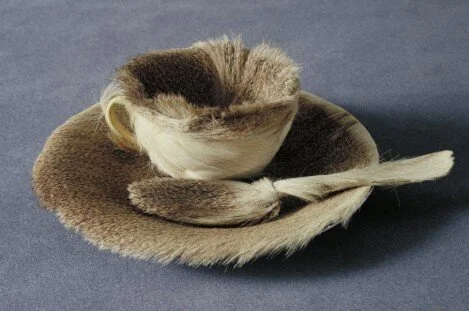On a personal level ‘Object Art’ has been one of the most difficult art genres for me to engage with. There have been many experiences for me where I have walked into a grand museum or gallery and seen an object like a single shoe in an empty white room. I just didn’t get it. I refused to give it time and I’m sure this single shoe was a terrible example of ‘Object Art’ but it had a profound effect that this type of art just wasn’t form me. It’s going to take some convincing.
Marcel Duchamp was the pioneer of this ‘Object Art’ and the movement of Dada. Formed in the First World War this artist genre tried to create satire in this time of uncertainty and horror. It broke all the rules and challenged what at the time was considered art. In 1913 Duchamp created ‘Bicycle Wheel’ a kinetic sculpture of an upside-down bicycle wheel drilled into a wooden stool. This was to be the first of his ‘Readymades’, Duchamp elevated everyday items to challenge the idea of taste. For me I started off disliking this piece, it looked crude maybe it even made me feel uncomfortable to start with but that is its power as an important piece of art. It challenged me, to think differently and I can see now that at the time it was so radical that it challenged the entire art world.
In 1936, whilst enjoying tea with Picasso, Meret Oppenheim had an idea that would lead her to create one of the most important surrealist objects of all time. Titled simply as ‘Object’ this delicate teacup, saucer and spoon are wrapped in the fur of a Chinese Gazelle. An idea that an everyday object that everyone is familiar with, can undergo a transformation to become art. It is still very much a teacup, by structure and form, but it questions how we might now interact with this object. In a very male dominate genre this propelled Oppenheim to greatness which paved the way for more female artists. I love this piece of object art, it plays with humour, it feels a little sinister maybe even a little erotic in its gesture to female form. Surrealism was used to challenge and bewilder sensation and this piece certainly does that. I imagine myself using this everyday object, holding the warm fur tea cup would almost emulate a small creature alive in your hand. Visualising, licking the sugar of the spoon makes me feel so uncomfortable, the sensation of the fur in your mouth is almost grotesque. A brilliant piece of art that plays with the senses.
‘Sky Cathedral’ created by Louise Nevelson really excited me. Its large, domineering presence within the clean white space feels like a giant void, or a gateway to another world. Nevelson’s family were in the timber trade and I feel like this was why she was drawn to the use of wood within her sculpture. Created in 1958, ‘Sky Cathedral’ is formed of over 60 wooden boxes, containing found wood from spindles, furniture and scraps and then solidified by the colour black.
“When I fell in love with black, it contained all colour. It wasn’t a negation of colour. It was an acceptance. Because black encompasses all colours. Black is the most aristocratic colour of all. … You can be quiet and it contains the whole thing.”
With its cubist composition, the shrine draws me in to really look at its objects that make up its form. I almost want to know what past life these objects hold now in their new arrangement. They have been born again.
‘Object Art’ has really confronted and challenged my feelings towards this type of art, which is exactly its intention. I’ve been to quick to dismiss this genre in the past as lazy or pretentious but taking a closer look at these well-known examples I have enjoyed the challenge. If an object can evoke a feeling, either of connection or even make us uncomfortable then the artist has created art.


